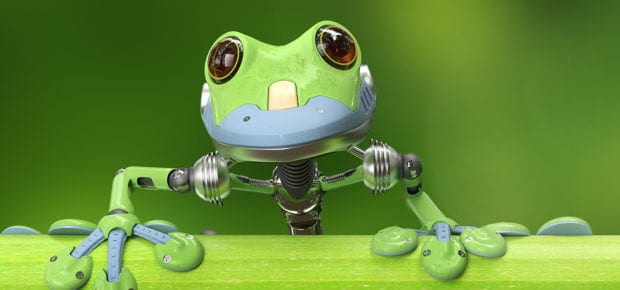September 7, 2018
Most organisms on Earth have a soft build. Skeletons typically make up a small proportion of our body mass, and the movement of creatures generally reflects that. So, when researchers work to create robots that move like natural organisms, things get complicated.
Soft robotics is an emerging field that’s transforming the way robots look and function. While you might associate robots with rigid metal structures (things like rods, pistons, actuators, motors, etc. aren’t exactly plush), soft robots house those features within a soft, pliable exterior.
Researchers studying soft robotics frame their broad goal as such: “The development of physical structures and behaviors that are more similar to those of living organisms can help robots to better negotiate real-world environments and accomplish real-world tasks.”
When it comes to real-world tasks, one use is allowing researchers to interact with animals in their natural habitat, since the very presence of humans is likely to alter it. IEEE Spectrum has written about a robotic fish that “moves more or less in the same way that real fish do,” and “didn’t scare nearby fish, although it’ll take more experimentation to figure out exactly what kind of impact a robotic fish like this has on the real thing.”
Research has also focused on skin shapes and textures for soft robots. In one study, recapped by IEEE Spectrum, where scientists worked to recreate the movement of a snake, analysis focused on the pattern for the skin. The version with trapezoidal shapes was the winner, “not because the trapezoidal shapes generated more friction—rather, the trapezoids allowed the skin to stretch more, which meant that the robot would elongate more when it inflated, yielding a longer ‘stride.’” This work is important for creating robots that can excel in tight spaces.
Work doesn’t end at the physical nature of animals. Plants are also inspiring advances in soft robotics, like the pinecone, which has inspired a soft actuator with bending capabilities.
The IEEE Robotics & Automation Society has a Technical Committee for Soft Robotics that is focusing on areas like the study of unconventional materials, tools and methods for fabrication, modeling and simulation, techniques to achieve sensing and more. They’re bringing together scientists and engineers to discuss these issues, as well as upcoming visionary ones, like self-repairing, growing, and self-replicating robots.





 Liquid Infrastructure: Our Planet's Most Precious Resource
Liquid Infrastructure: Our Planet's Most Precious Resource The Impact of Technology in 2025
The Impact of Technology in 2025 Quantum and AI: Safeguards or Threats to Cybersecurity?
Quantum and AI: Safeguards or Threats to Cybersecurity? Why AI Can't Live Without Us
Why AI Can't Live Without Us Bits, Bytes, Buildings and Bridges: Digital-Driven Infrastructure
Bits, Bytes, Buildings and Bridges: Digital-Driven Infrastructure Impact of Technology in 2024
Impact of Technology in 2024 Emerging AI Cybersecurity Challenges and Solutions
Emerging AI Cybersecurity Challenges and Solutions The Skies are Unlimited
The Skies are Unlimited Smart Cities 2030: How Tech is Reshaping Urbanscapes
Smart Cities 2030: How Tech is Reshaping Urbanscapes Impact of Technology 2023
Impact of Technology 2023 Cybersecurity for Life-Changing Innovations
Cybersecurity for Life-Changing Innovations Smarter Wearables Healthier Life
Smarter Wearables Healthier Life Infrastructure In Motion
Infrastructure In Motion The Impact of Tech in 2022 and Beyond
The Impact of Tech in 2022 and Beyond Cybersecurity, Technology and Protecting Our World
Cybersecurity, Technology and Protecting Our World How Technology Helps us Understand Our Health and Wellness
How Technology Helps us Understand Our Health and Wellness The Resilience of Humanity
The Resilience of Humanity Harnessing and Sustaining our Natural Resources
Harnessing and Sustaining our Natural Resources Creating Healthy Spaces Through Technology
Creating Healthy Spaces Through Technology Exceptional Infrastructure Challenges, Technology and Humanity
Exceptional Infrastructure Challenges, Technology and Humanity The Global Impact of IEEE's 802 Standards
The Global Impact of IEEE's 802 Standards Scenes of our Cyber Lives: The Security Threats and Technology Solutions Protecting Us
Scenes of our Cyber Lives: The Security Threats and Technology Solutions Protecting Us How Millennial Parents are Embracing Health and Wellness Technologies for Their Generation Alpha Kids
How Millennial Parents are Embracing Health and Wellness Technologies for Their Generation Alpha Kids Space Exploration, Technology and Our Lives
Space Exploration, Technology and Our Lives Global Innovation and the Environment
Global Innovation and the Environment How Technology, Privacy and Security are Changing Each Other (And Us)
How Technology, Privacy and Security are Changing Each Other (And Us) Find us in booth 31506, LVCC South Hall 3 and experience the Technology Moon Walk
Find us in booth 31506, LVCC South Hall 3 and experience the Technology Moon Walk Virtual and Mixed Reality
Virtual and Mixed Reality How Robots are Improving our Health
How Robots are Improving our Health IEEE Experts and the Robots They are Teaching
IEEE Experts and the Robots They are Teaching See how millennial parents around the world see AI impacting the lives of their tech-infused offspring
See how millennial parents around the world see AI impacting the lives of their tech-infused offspring Take the journey from farm to table and learn how IoT will help us reach the rising demand for food production
Take the journey from farm to table and learn how IoT will help us reach the rising demand for food production Watch technical experts discuss the latest cyber threats
Watch technical experts discuss the latest cyber threats Explore how researchers, teachers, explorers, healthcare and medical professionals use immersive technologies
Explore how researchers, teachers, explorers, healthcare and medical professionals use immersive technologies Follow the timeline to see how Generation AI will be impacted by technology
Follow the timeline to see how Generation AI will be impacted by technology Learn how your IoT data can be used by experiencing a day in a connected life
Learn how your IoT data can be used by experiencing a day in a connected life Listen to technical experts discuss the biggest security threats today
Listen to technical experts discuss the biggest security threats today See how tech has influenced and evolved with the Games
See how tech has influenced and evolved with the Games Enter our virtual home to explore the IoT (Internet of Things) technologies
Enter our virtual home to explore the IoT (Internet of Things) technologies Explore an interactive map showcasing exciting innovations in robotics
Explore an interactive map showcasing exciting innovations in robotics Interactively explore A.I. in recent Hollywood movies
Interactively explore A.I. in recent Hollywood movies Get immersed in technologies that will improve patients' lives
Get immersed in technologies that will improve patients' lives